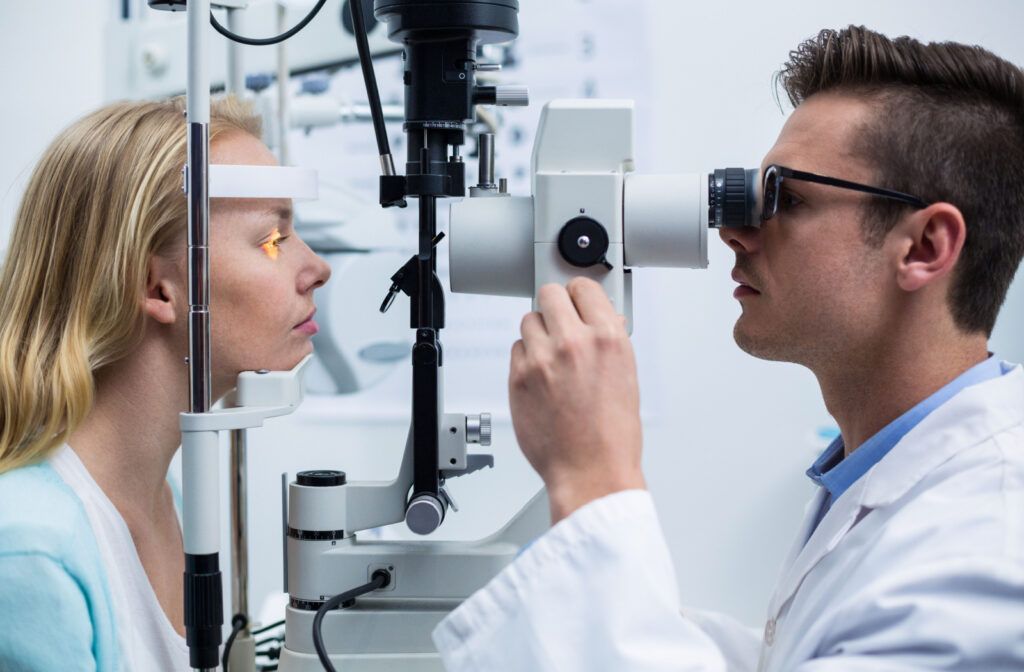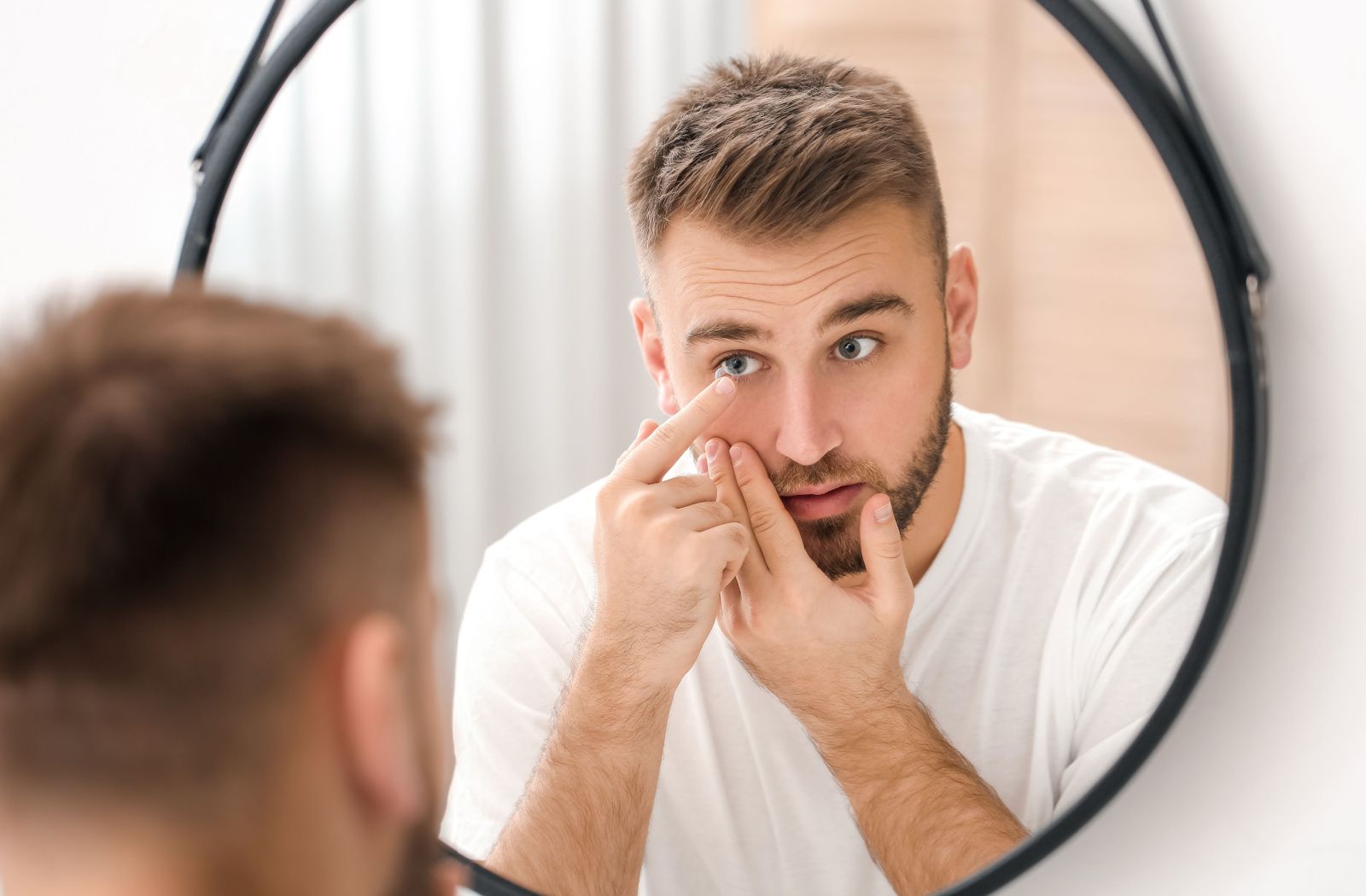If you have dry eye disease, you’re not alone. Millions of Canadians suffer from this frustrating, all too common eye condition. Combine that number with the millions of Canadians who choose to wear contact lenses to correct blurry vision, and it’s no wonder many people are searching for the best contacts for dry eyes.
It can be challenging to find contacts that provide comfort all day without causing further irritation or discomfort. The best contacts for dry eyes depend on your unique lifestyle and needs but could include:
- Soft contact lenses
- Hybrid contact lenses
- Gas-permeable scleral contact lenses
- Daily disposable contact lenses
Dry Eyes & Contact Lenses
The most common culprit behind dry eyes is meibomian gland dysfunction (MGD). This occurs when the meibomian glands lining your eyelids become inflamed or clogged. These glands are vital for creating meibum, an oil that prevents your tears from evaporating too fast. When they’re clogged, you may experience dry eye symptoms, such as:
- Blurry vision
- Burning, stinging, and gritty sensations
- Redness
- Eye fatigue
- The feeling of something foreign stuck in your eye
- Excessive watery eyes
- Difficulty wearing contact lenses
Dry eyes can turn daily tasks like computer work, reading, and watching TV into frustrating and uncomfortable experiences. Since some studies have shown contact lenses could actually worsen dry eye symptoms, it’s vital to get lenses that support your relief rather than hinder it.
How Can Contacts Make Dry Eyes Worse?
Contact lenses are a lot like your eyes, they work better when hydrated. Despite that, contacts with a high water content might increase your likelihood of developing dry eyes. We know it sounds backwards. You’d think more water means more hydration, but that’s not always true.
Here’s what’s happening: the water in those high-water-content lenses can pull lipids and proteins from your eyes. This throws off the tear film that keeps your eyes moist and could lead to the lens dehydrating. Some contact lens wearers may be unaffected, but if you’re already struggling with dry eyes, this could tip things into uncomfortable territory once the lens dries out.
Contacts for Dry Eyes
Your optometrist might have you try a few different contact lenses to find the pair that feels most comfortable to you.
Soft Contact Lenses
Soft contact lenses are the most commonly prescribed type of contacts, and they come in different designs, sizes, and materials. People with dry eye may enjoy soft contacts for their comfort and flexibility.
Although traditional hydrogel lenses are popular, advances in contact lens technology have led to the development of silicone hydrogel lenses, which can let more oxygen reach the eye than their hydrogel counterparts.
They’re especially beneficial for those who experience severe dry eye symptoms. While hydrogel lenses with high water content can absorb moisture from your tears, silicone hydrogel doesn’t rely on water content for comfort. This allows soft lenses to stay comfy without drying your eyes.
Daily Disposable Contact Lenses
Contact lenses can pick up bacteria and protein as you wear them, which is why they need to be properly cleaned every day. Instead, why not wear a fresh pair every day? This is why daily disposable lenses are possibly the most hygienic type of soft contact lens.
As their name implies, daily disposable lenses are worn for one day and then discarded, eliminating the need for cleaning and storage. They’re an excellent choice for people with dry eyes, as they provide a fresh lens every day, and there’s less chance of bacteria or protein buildup, which can cause dry eyes or irritation.
Hybrid Contact Lenses
Hybrid contact lenses are a combination of soft and rigid gas-permeable (RGP) contact lenses. They have a rigid centre surrounded by a soft, comfortable outer layer. Hybrid lenses can provide better visual acuity than soft lenses, paired with more comfort than strictly RGP lenses.
Think of them as taking the advantage of each type of contact lens. They allow high oxygen permeability, making them an excellent option for mild dry eye sufferers who want the benefits of rigid lenses without sacrificing comfort.
Scleral Contact Lenses
Scleral contact lenses are large RGP contact lenses that vault over the entire cornea and rest on the sclera (the white part of your eye). The space between the lens and the cornea creates a reservoir, providing moisture and preventing the lens from making direct contact with the eye’s surface.
Scleral lenses have become a popular choice for people with dry eyes. What’s more, scleral lenses can work great for individuals with irregular corneas, high astigmatism, and post-surgical complications.

Your Path to Dry Eye Relief
Finding the best contact lenses for dry eyes may require some research and experimentation. However, considering the different options available today, our knowledgeable team at Spectrum Eye Care can help you find the lenses that work for you.We’re dedicated to using our eye care technology to diagnose dry eye symptoms and treat blockages caused by meibomian gland dysfunction. With the right combination of lens type and fit, you can enjoy a comfortable and clear vision without the discomfort of dry eyes. Book your appointment today and let’s get started on your dry eye relief.

